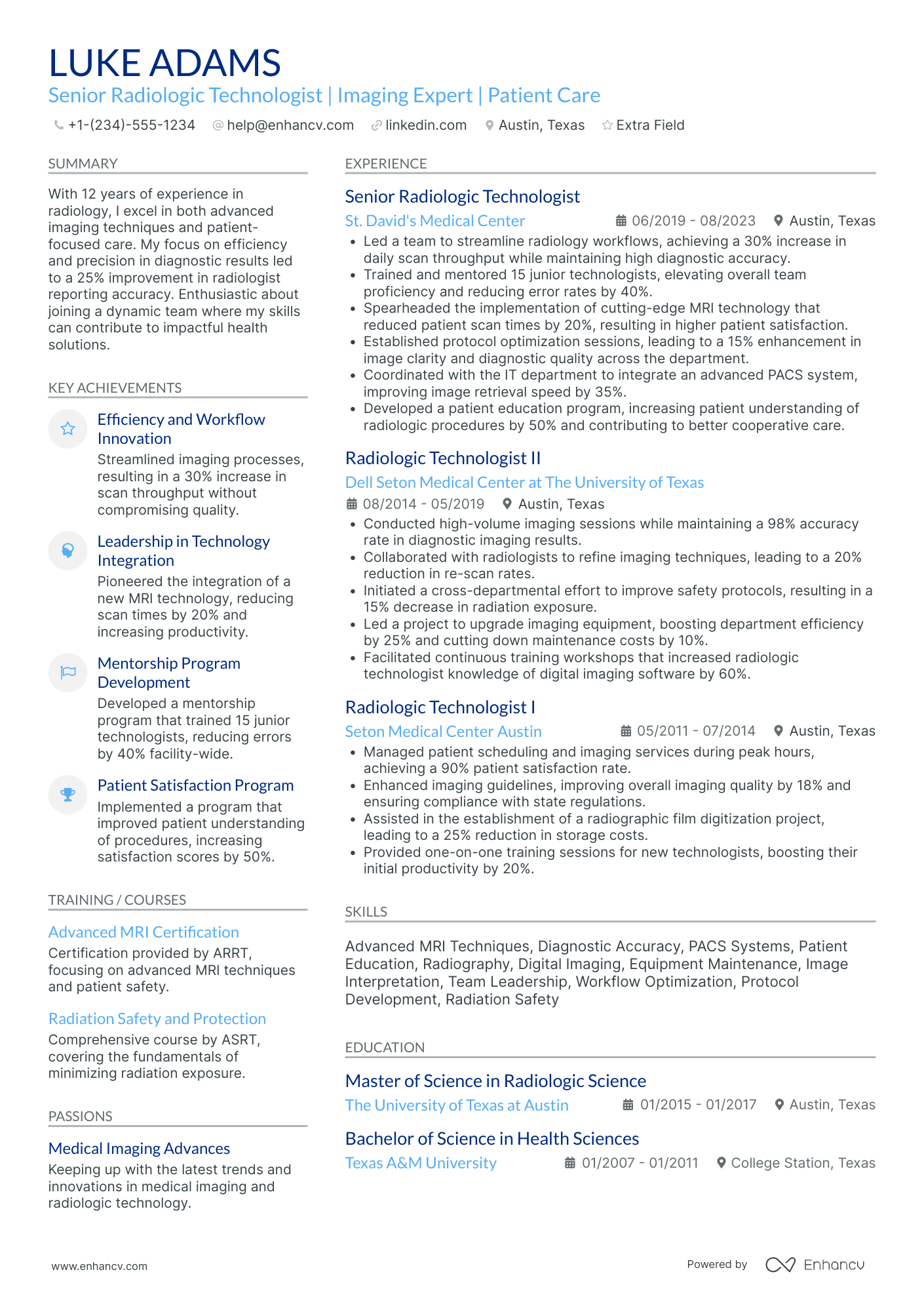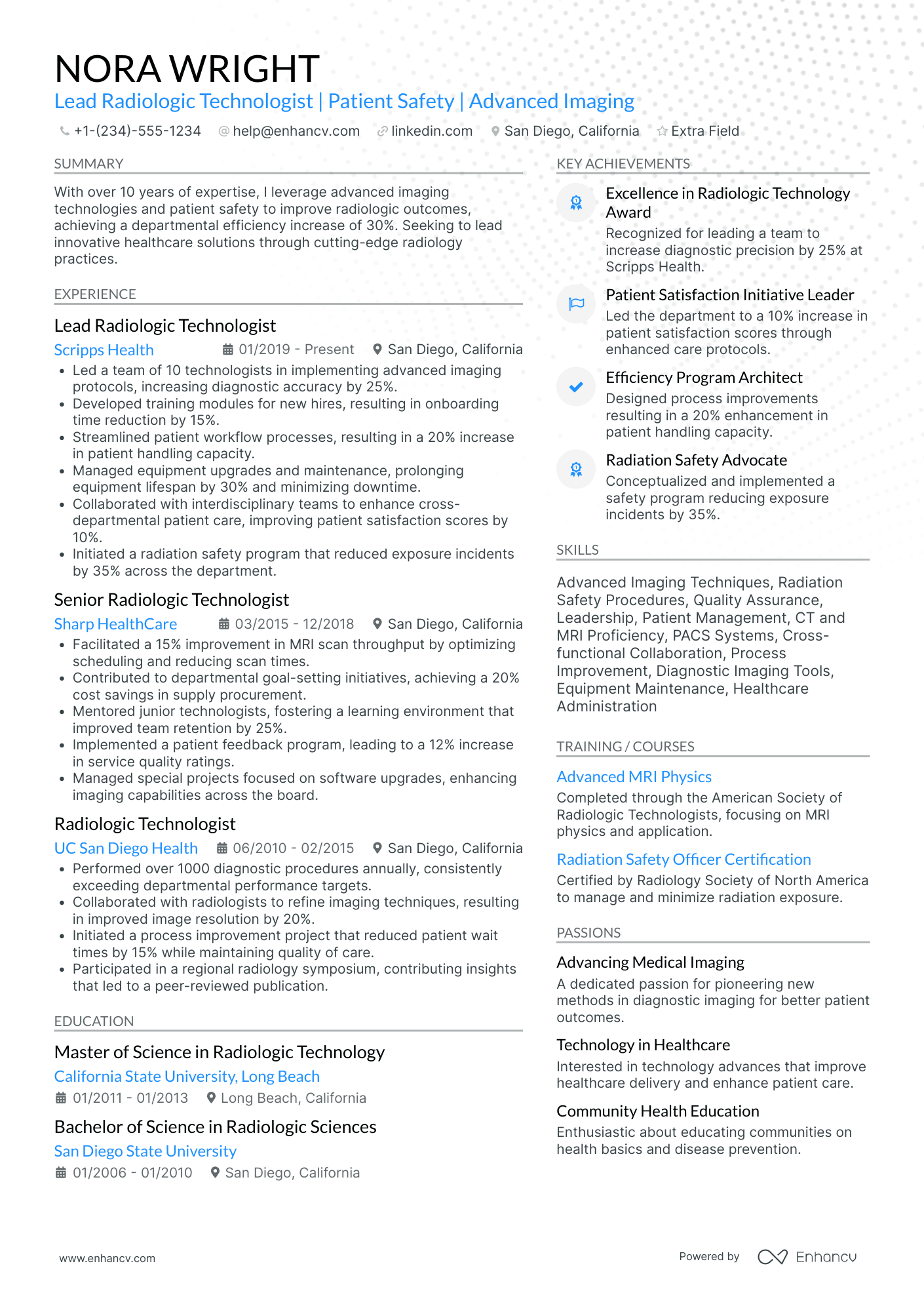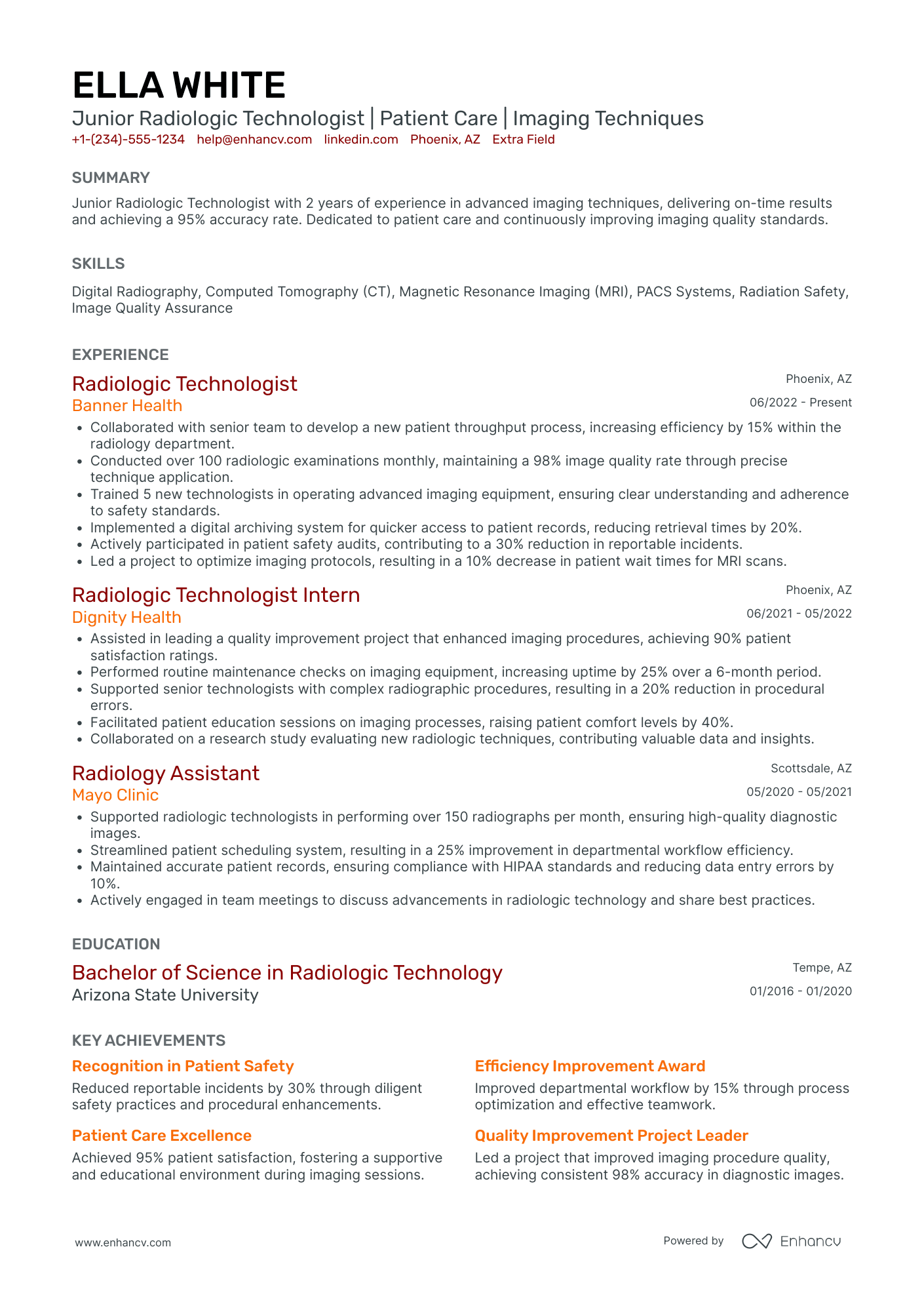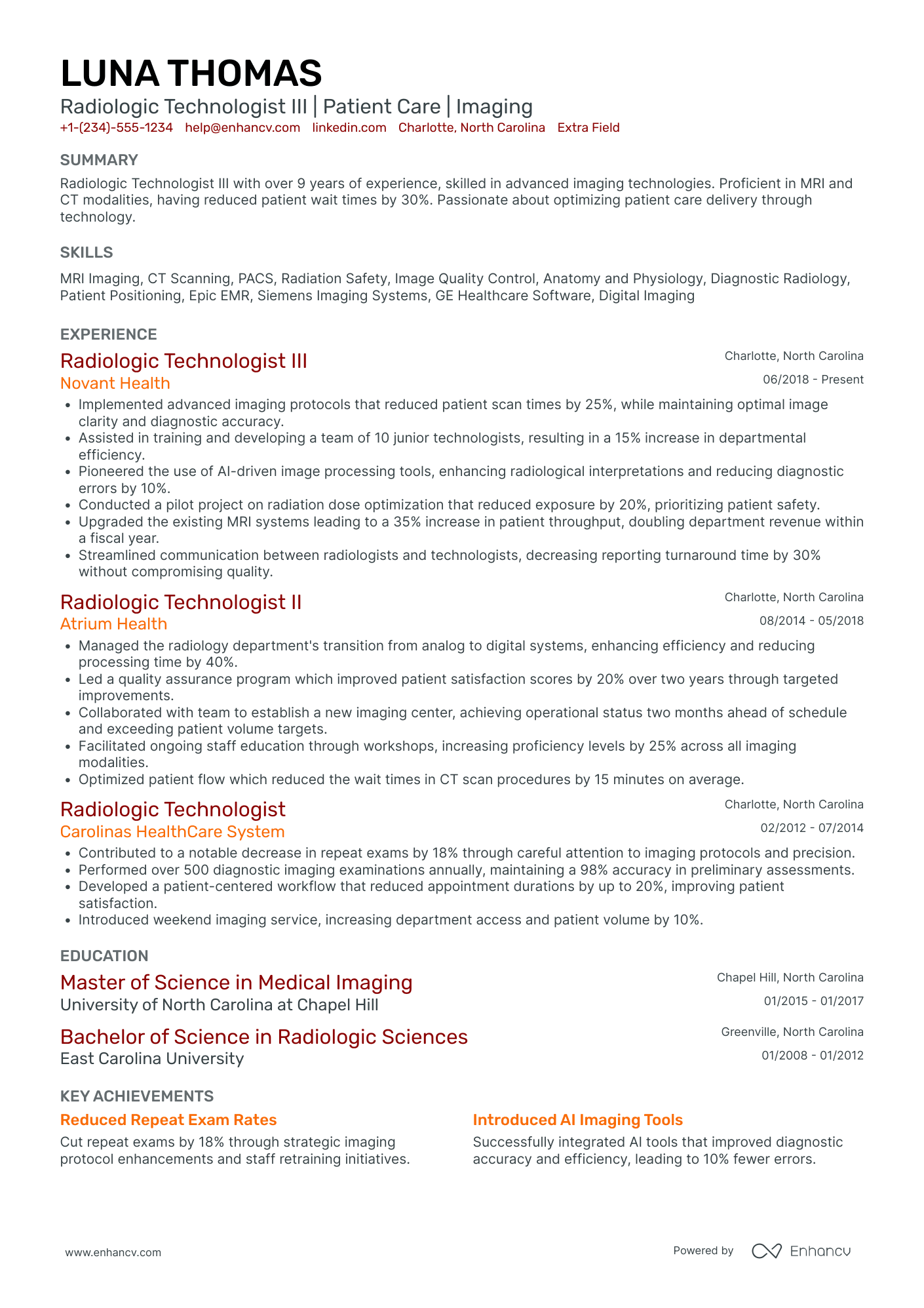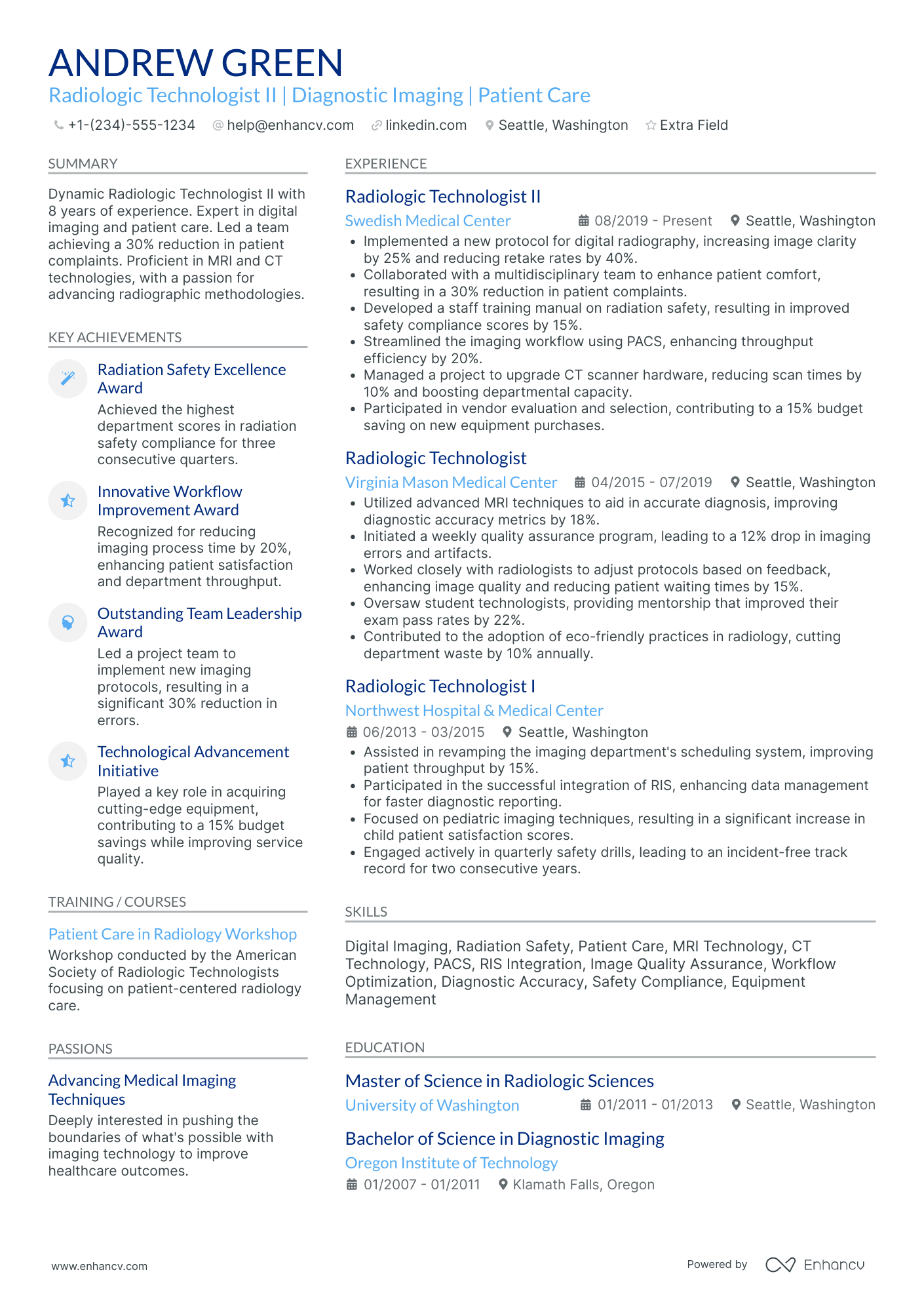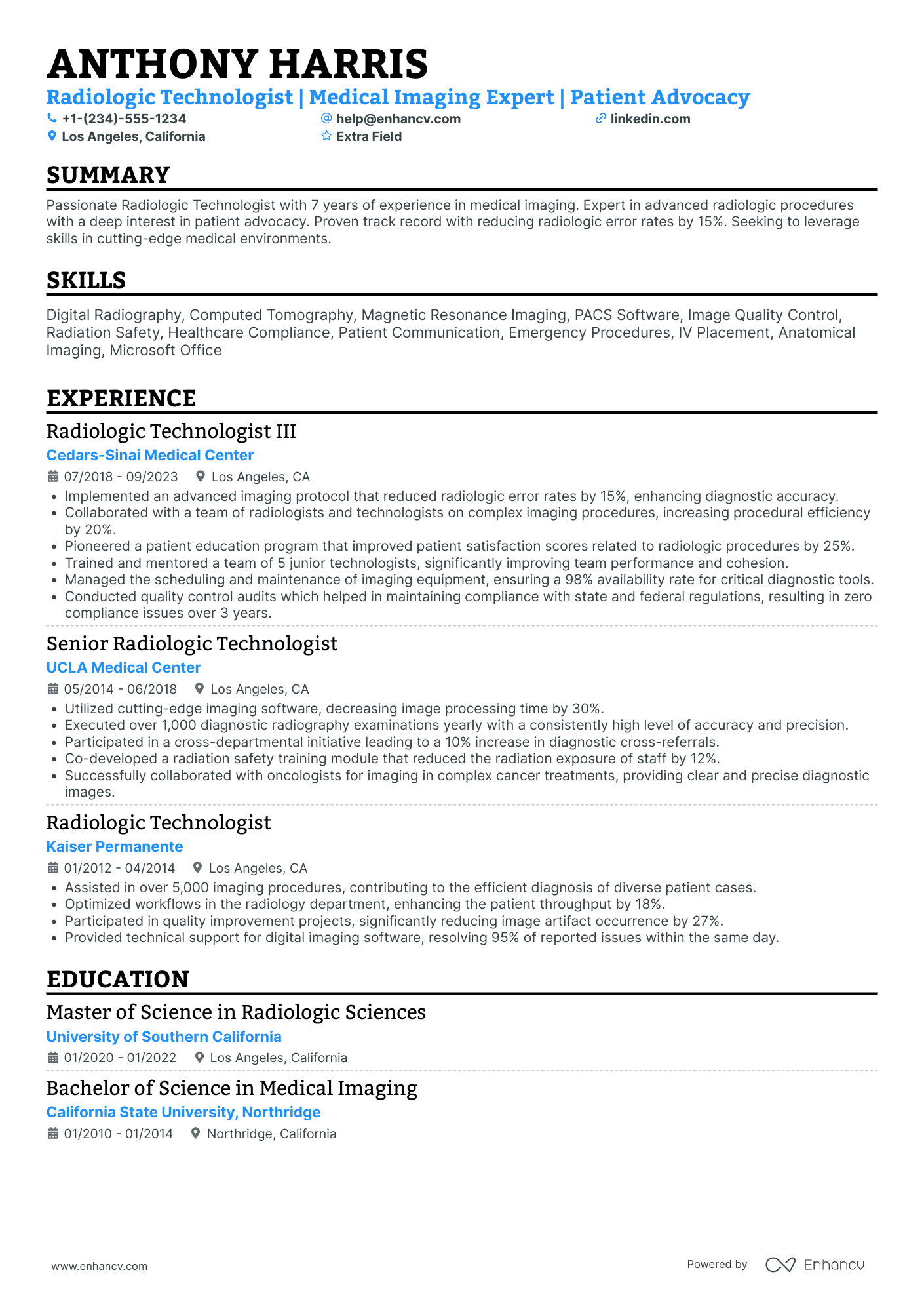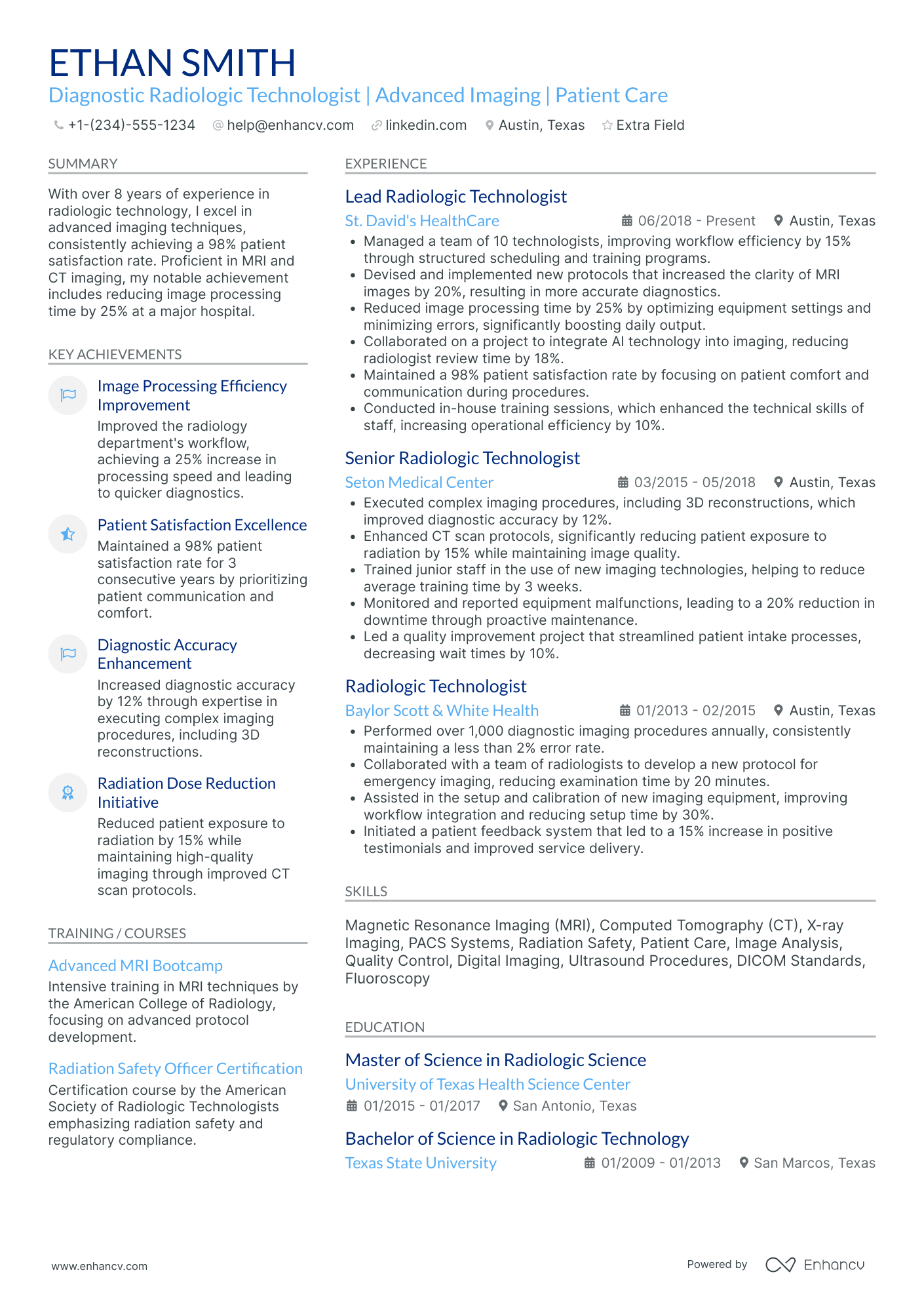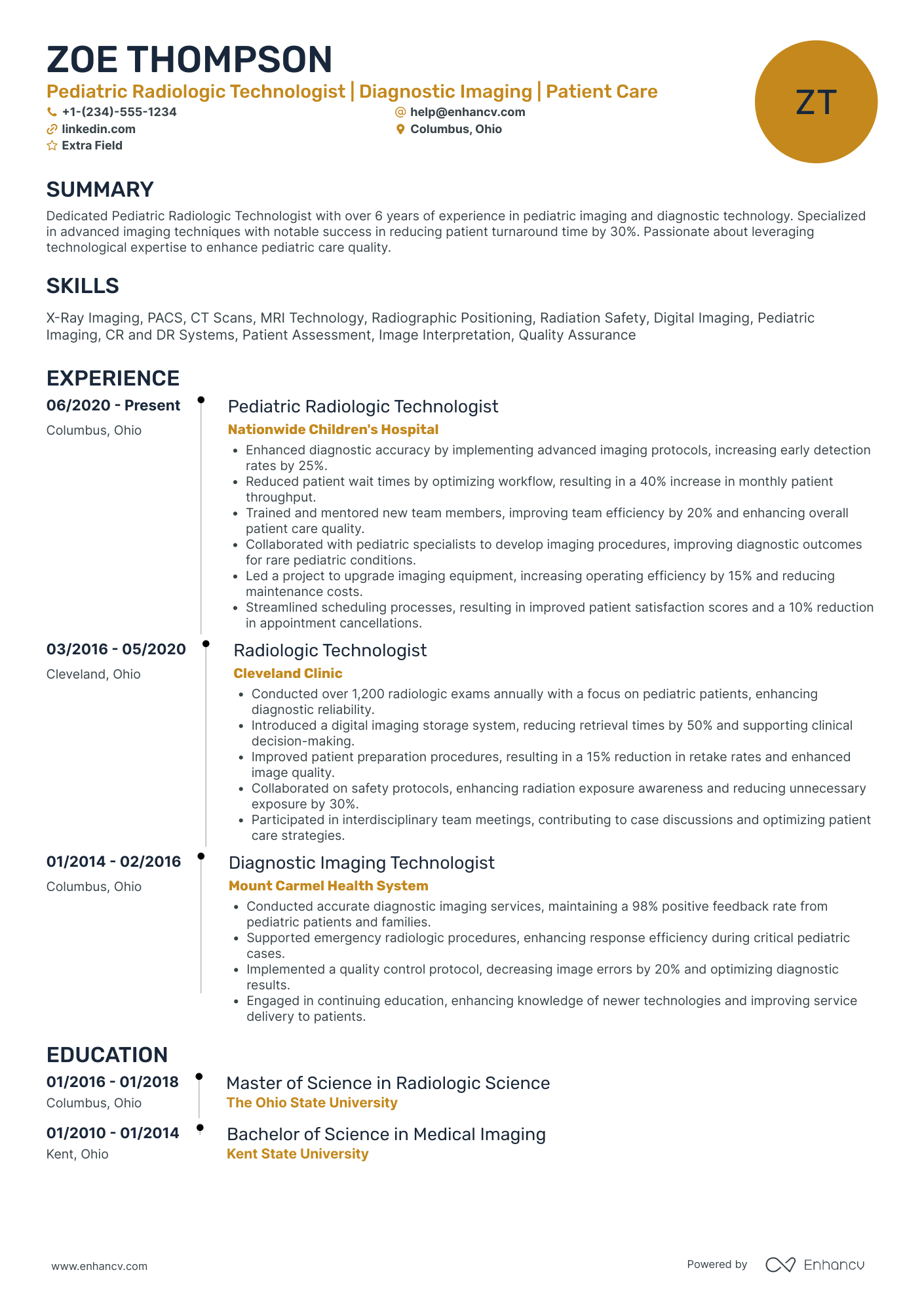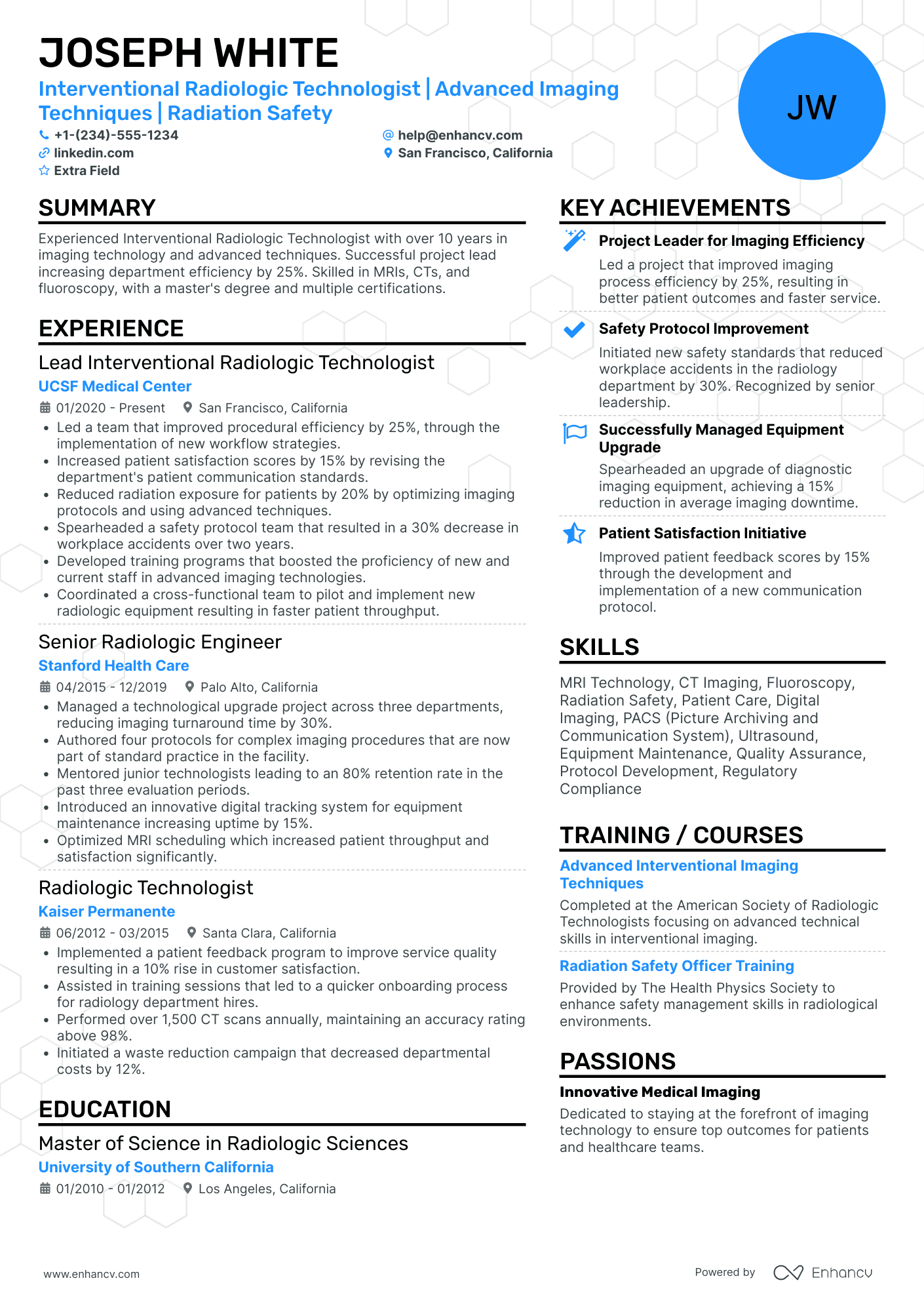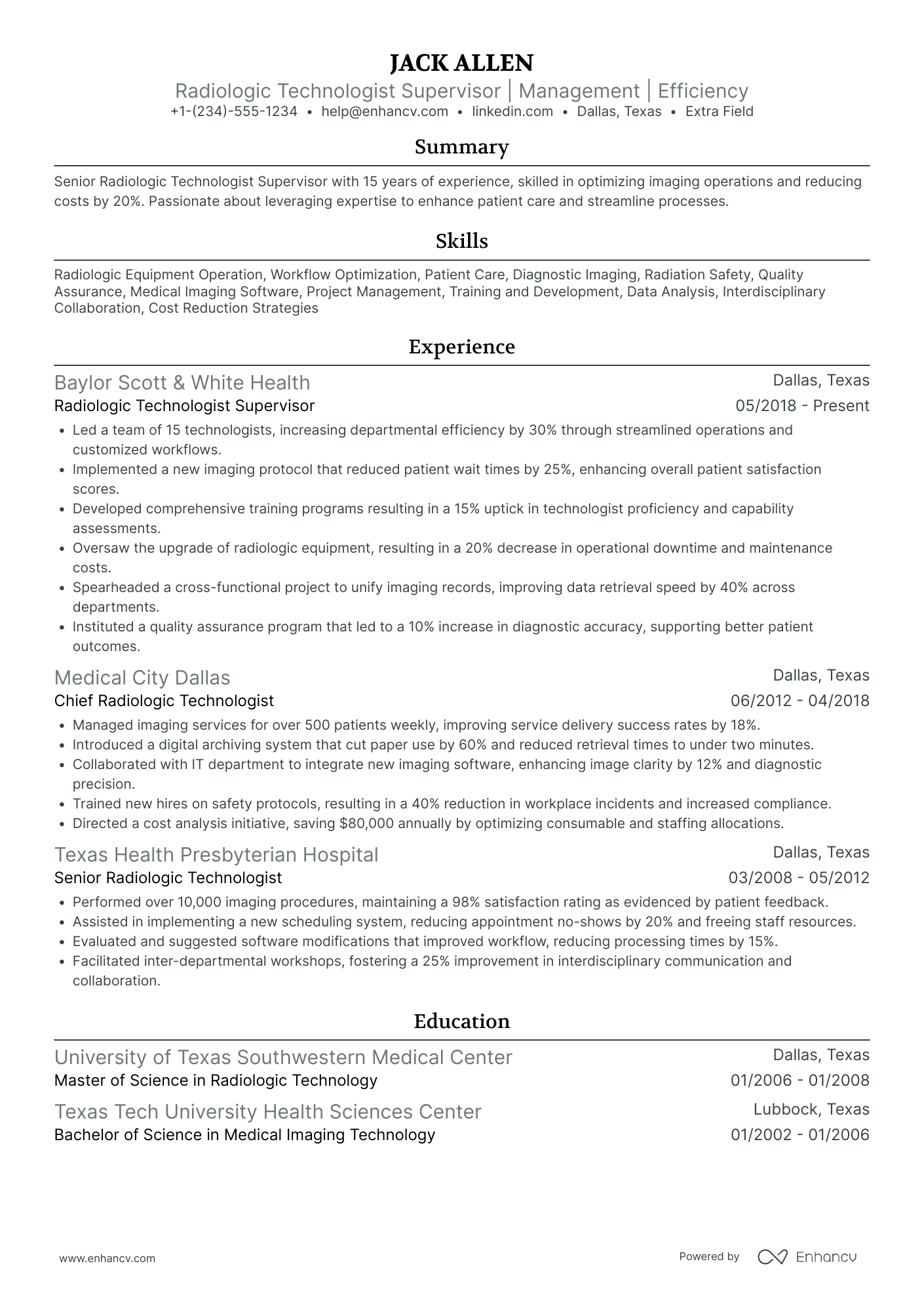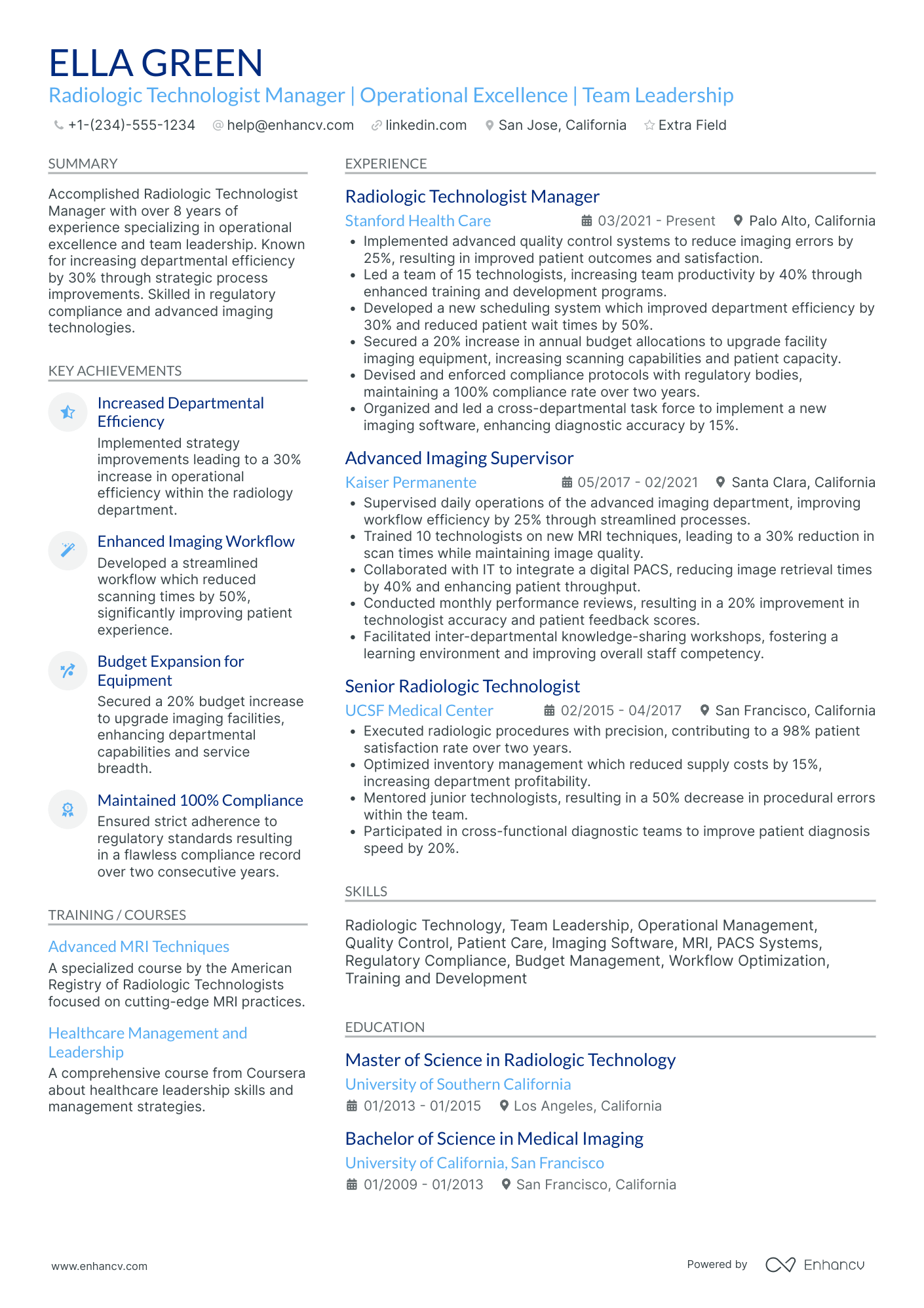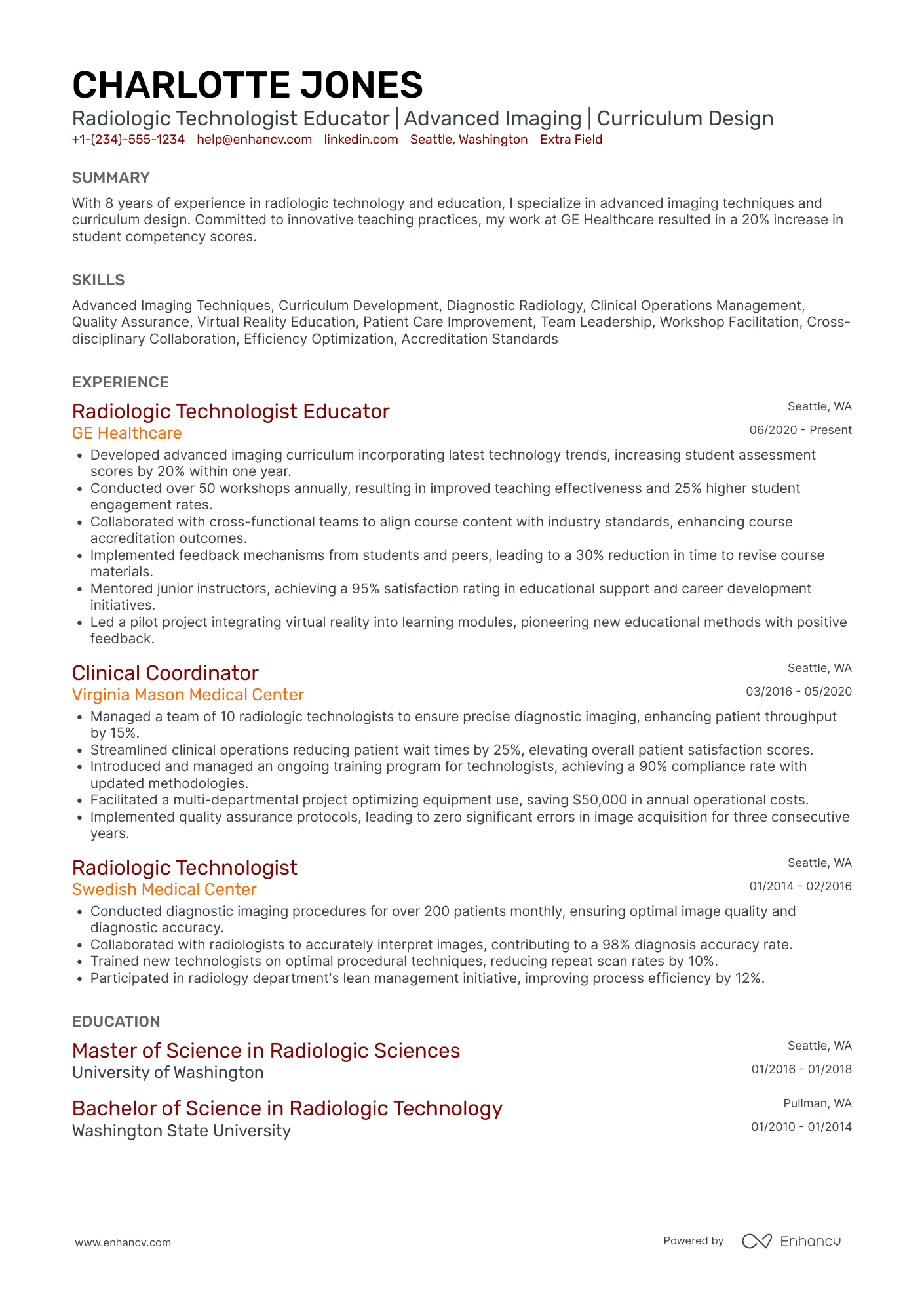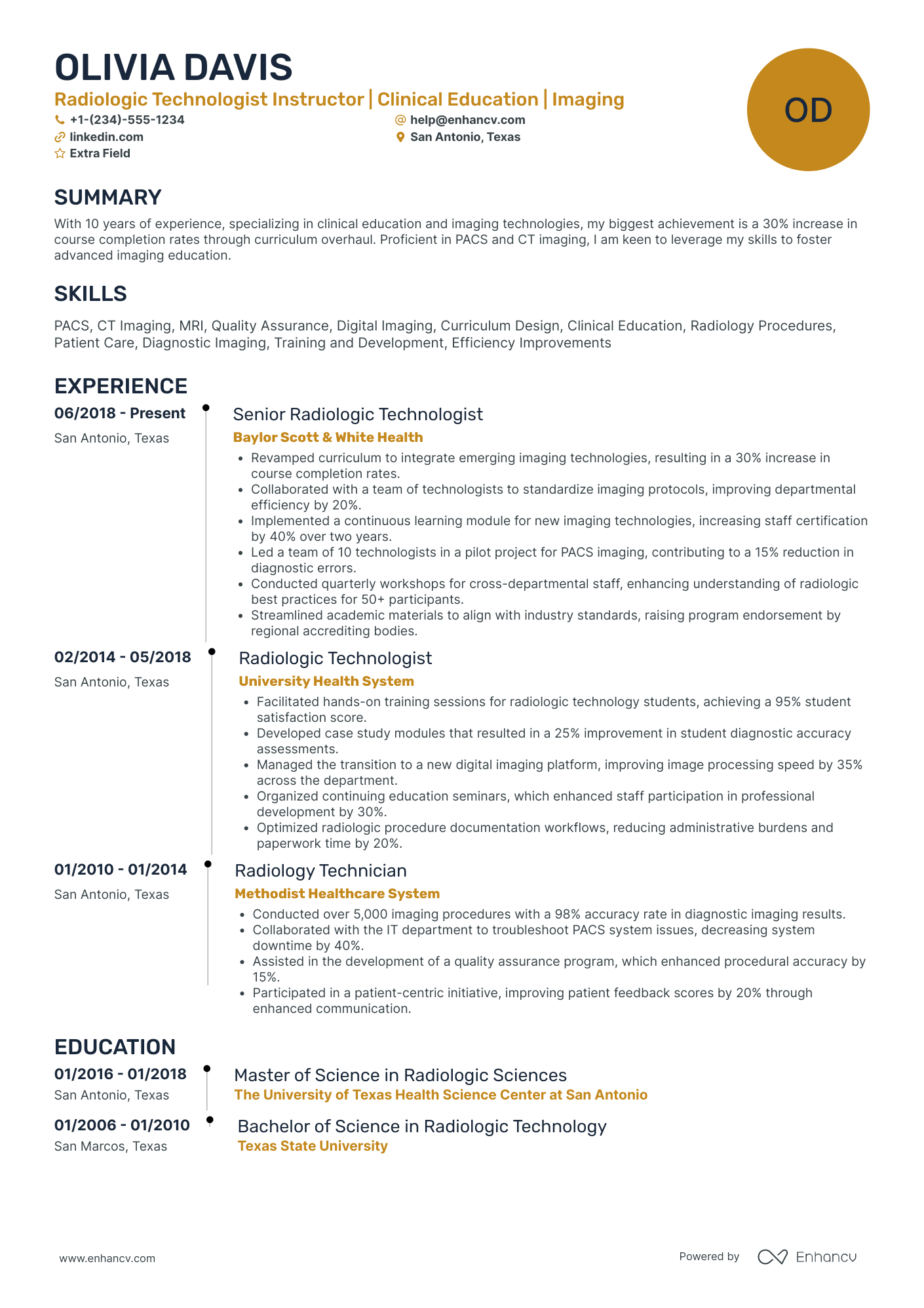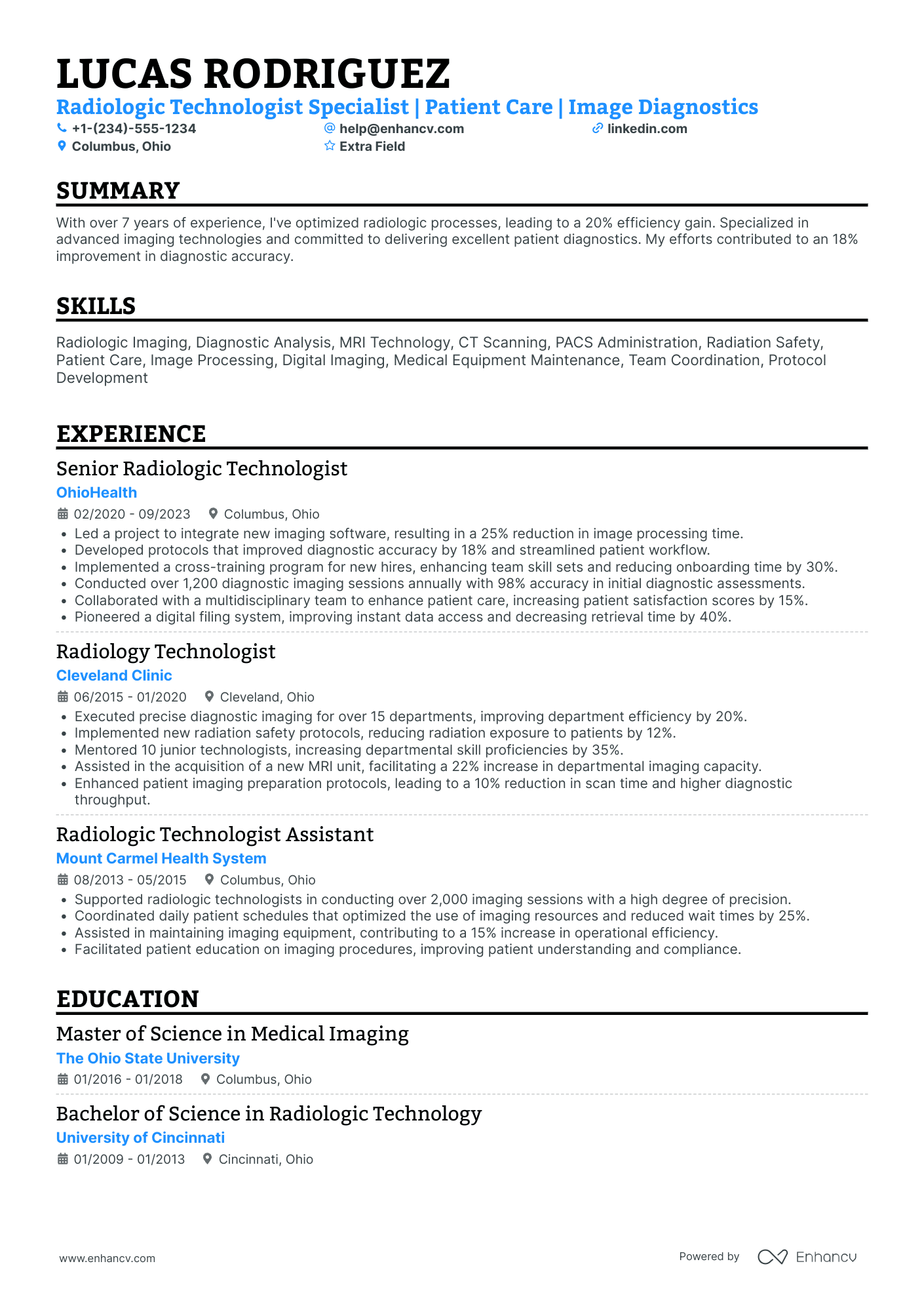As a radiologic technologist, effectively showcasing your expertise with advanced imaging technologies on your resume can be a significant challenge. Our comprehensive guide steers you through this process, providing tailored strategies to highlight your skills and make your application stand out to employers.
- Sample industry-leading examples to learn how to write your best resume yet.
- Improve the experience, education, and achievements section of your resume with insights from resume-writing professionals.
- Curate your technical expertise and personality to stand out amongst the pool of candidates.
- Succinctly focus on your unique skill set all through your radiologic technologist resume.
If the radiologic technologist resume isn't the right one for you, take a look at other related guides we have:
Formatting the layout of your radiologic technologist resume: design, length, and more
When it comes to the format of your radiologic technologist resume , you've plenty of opportunities to get creative. But, as a general rule of thumb, there are four simple steps you could integrate into your resume layout.
- If you have plenty of experience, you'd like to showcase, invest in the reverse-chronological resume format . This format focuses on your latest experience items and skills you've learned during your relevant (and recent) jobs.
- Don't go over the two-page limit, when creating your professional radiologic technologist resume. Curate within it mainly experience and skills that are relevant to the job.
- Make sure your radiologic technologist resume header includes all of your valid contact information. You could also opt to display your professional portfolio or LinkedIn profile.
- Submit or send out your radiologic technologist resume as a PDF, so you won't lose its layout and design.
Customize your resume for the market – a Canadian format, for example, might vary in structure.
Upload & Check Your Resume
Drop your resume here or choose a file. PDF & DOCX only. Max 2MB file size.
PRO TIP
If you failed to obtain one of the certificates, as listed in the requirements, but decide to include it on your resume, make sure to include a note somewhere that you have the "relevant training, but are planning to re-take the exams". Support this statement with the actual date you're planning to be re-examined. Always be honest on your resume.
Traditional sections, appreciated by recruiters, for your radiologic technologist resume:
- Clear and concise header with relevant links and contact details
- Summary or objective with precise snapshot of our career highlights and why you're a suitable candidate for the radiologic technologist role
- Experience that goes into the nuts and bolts of your professional qualifications and success
- Skills section(-s) for more in-depth talent-alignment between job keywords and your own profile
- Education and certifications sections to further show your commitment for growth in the specific niche
What recruiters want to see on your resume:
- Certifications and licenses, such as American Registry of radiologic technologists (ARRT) certification and applicable state licensure.
- Technical proficiency in operating imaging equipment like X-ray, CT, MRI, and understanding of radiation safety protocols.
- Clinical experience with patient positioning, imaging procedures, and ability to work with different populations (e.g., pediatrics, geriatrics).
- Knowledge of medical terminology, anatomy, and physiology relevant to radiologic technology.
- Skills in digital record keeping, PACS (Picture Archiving and Communication System), and RIS (Radiology Information System) usage.
Quick guide to your radiologic technologist resume experience section
After deciding on the format of your resume, it's time to organize your experience within the dedicated section.
It's common for radiologic technologist professionals to be confused in this part of the process, as they may have too much or little expertise.
Follow the general rules of thumb to be successful when writing this part of your resume:
- The perfect number of bullets you should have under each experience item is no more than six;
- Select not merely your responsibilities, but the most noteworthy achievements for each role that match the job requirements;
- List any certificates or technical expertise you've gained on the job and how they've helped you progress as a professional;
- Carefully select the power verbs to go along with each bullet to avoid generic ones like "managed" and instead substitute those with the actuality of your particular responsibility;
- Integrate valuable keywords from the job advert in the form of achievements under each role you list.
If you're on the search for further advice on how to write your radiologic technologist experience section, get some ideas from real-world professional resumes:
- Supervised a team of 10 radiology technicians, ensuring adherence to safety protocols and delivering an average of 30 radiologic procedures daily.
- Implemented a new digital image archiving system that increased retrieval efficiency by 40%s, enhancing patient outcomes and staff productivity.
- Collaborated with radiologists to refine imaging processes, reducing average patient wait times for results by 25% and improving patient satisfaction scores.
- Performed over 5,000 diagnostic imaging procedures with a high degree of precision, contributing to accurate diagnosis and treatment plans.
- Trained and mentored 15 new technologists in advanced imaging techniques, resulting in increased departmental efficiency and reduced error rates.
- Led a cross-functional team to pilot a radiation dose reduction project, cutting average dose per patient by 20% without compromising image quality.
- Spearheaded the integration of a new MRI software that reduced scan time by an average of 15 minutes, enhancing throughput by 30%.
- Managed inventory and procurement of imaging supplies for the department, achieving a cost saving of 10% annually through vendor negotiations.
- Coordinated with healthcare providers to optimize the scheduling system, resulting in a 90% on-time start for all radiologic exams.
- Operated a variety of imaging equipment, including X-ray, CT, and MRI machines, performing an average of 20 scans per day with a 95% patient satisfaction rate.
- Participated in the research and development of a new contrast agent application technique, reducing patient discomfort and improving image clarity.
- Assisted in the coordination of the radiology department's move to a new hospital wing, minimizing downtime and resuming full operations within 48 hours.
- Conducted routine and complex diagnostic radiographic procedures, including fluoroscopy and mammography, maintaining a 99% accuracy rate in imaging interpretation.
- Engaged in continuous improvement efforts that led to a 15% decrease in image retakes, conserving resources and reducing patient exposure to radiation.
- Actively contributed to departmental accreditation by the Joint Commission, ensuring compliance with all health and safety regulations.
- Focused on pediatric imaging, adapting communication and technical approaches to suit young patients, which increased the department's pediatric throughput by 20%.
- Developed a patient positioning guide that became a standard reference in the department, improving image consistency and reducing re-scan rates by 18%.
- Received the 'Technologist of the Year' award for exceptional service and innovative techniques that significantly enhanced department operations.
- Led the adoption of low-dose imaging protocols in alignment with ALARA principles, leading to a hospital-wide reduction in patient radiation exposure.
- Designed and administered continuing education programs for the radiology department staff, raising the level of expertise and resulting in a 5% increase in departmental performance efficiency.
- Managed the transition to a fully digital radiography system, which cut film costs by 100% and storage requirements by 70%.
- Coordinated the work schedules of 25 staff members to ensure 24/7 coverage of radiologic services, fulfilling all emergency and routine imaging needs.
- Led the quality control and assurance programs within the radiology department that helped maintain accreditation standards and reduce patient complaints by 10%.
- Orchestrated a department-wide quality initiative that increased the accuracy of diagnostic imaging reports by 12%, directly impacting patient care and treatment efficacy.
Quantifying impact on your resume
- Indicate the number of diagnostic imaging procedures you perform on average per day to demonstrate your efficiency and capability in handling a high volume of work.
- Highlight the percentage of reduction in patient wait times you achieved through process improvements to illustrate your commitment to enhancing patient satisfaction.
- Mention the number of new radiologic technologists you have trained or mentored to show your leadership skills and contribution to team development.
- Quantify your experience with various imaging equipment and techniques, specifying how many types of machinery you are proficient with to emphasize your technical versatility.
- Detail the specific reduction in retake rates due to your precision and attention to detail, which can show your ability to produce quality work and minimize waste.
- Report any successful implementation of new protocols or procedures, including the impact on workflow efficiency or safety, to underscore your innovative approach.
- Describe the extent of your involvement in cross-departmental collaborations by detailing the number of departments you work with regularly to demonstrate your adaptability and teamwork.
- Include the scope of your administrative duties by quantifying the volume of records or reports you manage, reflecting your organizational skills and ability to handle multifaceted tasks.
Action verbs for your radiologic technologist resume
Radiologic technologist resume without experience: a walk-through guide
If you don't happen to have any relevant experience yet, you can substitute this with:
- Short-term gigs and stunts - like month-long internships, that you have done during your university days
- Contract work - be specific about the relevance and outcomes of each role you include
- Resume format that prioritizes your skills - the functional-skill-based format or hybrid format could work
- Research roles - feature those especially prominently if you've participated in a noteworthy project or your role was of utmost importance to the project's success.
Recommended reads:
PRO TIP
If you happen to have plenty of certificates, select the ones that are most applicable and sought-after across the industry. Organize them by relevance to the role you're applying for.
Creating your radiologic technologist resume skills section: balancing hard skills and soft skills
Recruiters hiring for radiologic technologist roles are always keen on hiring candidates with relevant technical and people talents. Hard skills or technical ones are quite beneficial for the industry - as they refer to your competency with particular software and technologies. Meanwhile, your soft (or people) skills are quite crucial to yours and the company's professional growth as they detail how you'd cooperate and interact in your potential environment. Here's how to describe your hard and soft skill set in your radiologic technologist resume:
- Consider what the key job requirements are and list those towards the top of your skills section.
- Think of individual, specific skills that help you stand out amongst competitors, and detail how they've helped you succeed in the past.
- Look to the future of the industry and list all software/technologies which are forward-facing.
- Create a separate, technical skills section to supplement your experience and further align with the radiologic technologist job advert. Find the perfect balance between your resume hard and soft skills with our two lists.
Top skills for your radiologic technologist resume:
X-ray Machines
Computed Tomography (CT)
Magnetic Resonance Imaging (MRI)
Fluoroscopy Equipment
Digital Imaging Software
Radiation Safety Protocols
Patient Positioning Techniques
Image Processing and Analysis
Quality Control Procedures
Medical Terminology
Communication Skills
Attention to Detail
Empathy
Problem-Solving Skills
Teamwork
Time Management
Adaptability
Critical Thinking
Patient Care
Stress Management
PRO TIP
Highlight any significant extracurricular activities that demonstrate valuable skills or leadership.
How to include your education and certifications on your resume
We're taking you back to your college days with this part of our guide, but including your relevant higher education is quite important for your resume.
Your degree shows recruiters your dedication to the industry, your recent and relevant know-how, and some form of experience in the field.
Your radiologic technologist resume education should:
- Include your applicable degrees, college (-s) you've graduated from, as well as start and end dates of your higher education;
- Skip your high school diploma. If you still haven't graduated with your degree, list that your higher education isongoing;
- Feature any postgraduate diplomas in your resume header or summary - this is the perfect space to spotlight your relevant MBA degree;
- Showcase any relevant coursework, if you happen to have less professional experience and think this would support your case in being the best candidate for the role.
As far as your job-specific certificates are concerned - choose up to several of the most recent ones that match the job profile, and include them in a dedicated section.
We've saved you some time by selecting the most prominent industry certificates below.
The top 5 certifications for your radiologic technologist resume:
- Registered radiologic technologist (R.T.(R)) - American Registry of radiologic technologists (ARRT)
- Certified Radiography Technologist (CRT) - State Licensure (varies by state)
- Magnetic Resonance Imaging Technologist (MRI) - American Registry of Magnetic Resonance Imaging Technologists (ARMRIT)
- Certified Nuclear Medicine Technologist (CNMT) - Nuclear Medicine Technology Certification Board (NMTCB)
- Registered Vascular Technologist (RVT) - American Registry for Diagnostic Medical Sonography (ARDMS)
PRO TIP
Highlight any significant extracurricular activities that demonstrate valuable skills or leadership.
Recommended reads:
Your radiologic technologist resume top one third: choosing between a resume summary or an objective
The top third of your resume is crucial, as recruiters might focus only on this section rather than reading the entire document. Therefore, it's important to carefully decide whether to include a resume summary or an objective.
- The resume summary encapsulates your most significant experiences, key achievements, and skills in the field. Ideal for candidates with substantial relevant experience, the summary previews what recruiters will find in the rest of your resume.
- The resume objective outlines your professional aspirations. It describes your career goals for the coming years and how you envision your role evolving in the prospective company. The resume objective is suitable if you have less professional experience and wish to emphasize various soft skills such as motivation, vision, and planning.
Explore some of the best examples of resume summaries and objectives from real-life professional resumes in the industry.
Resume summaries for a radiologic technologist job
- With over 7 years of experience performing diagnostic imaging procedures in a high-volume hospital, a diligent and proficient radiologic technologist excels in fast-paced environments. Instrumental in reducing patient wait times by 20% through efficient workflow optimization and has expertise in MRI, CT scans, and X-ray technology.
- Transitioning from a 10-year tenure as a Healthcare Project Manager, this candidate has developed strong organizational and problem-solving skills, seeks to leverage their extensive knowledge of patient care protocols and radiographic techniques in a radiologic technologist role.
- An award-winning radiologic technologist with 5 years of experience specializing in pediatric radiology at a dedicated children's hospital. Recognized for developing patient positioning techniques that improved image clarity by 30%. Holds ARRT certification and is passionate about advancing non-invasive diagnostic methods.
- Former Information Technology specialist with a keen eye for detail and problem-solving, aiming to apply a decade of systems analysis expertise to the precision-oriented field of radiology. Seeking a career change to impact patient outcomes through technological advancements in diagnostic imaging.
- Recent graduate with an Associate's degree in radiologic technology, aspiring to contribute to high standards of patient care through cutting-edge imaging techniques. Eager to join a dynamic team to enhance diagnostic accuracy and gain invaluable hands-on experience in a reputed healthcare setting.
- A newcomer to radiologic science but with a background in biology and customer service, aiming to bring a strong foundation in anatomy and a patient-centric approach to delivering quality diagnostic imaging. Enthusiastic about starting a career in radiology and committed to lifelong learning in medical imaging practices.
Optimize your resume summary and objective for ATS
Drop your resume here or choose a file.
PDF & DOCX only. Max 2MB file size.
Showcasing your personality with these four radiologic technologist resume sections
Enhance your radiologic technologist expertise with additional resume sections that spotlight both your professional skills and personal traits. Choose options that not only present you in a professional light but also reveal why colleagues enjoy working with you:
- My time - a pie chart infographic detailing your daily personal and professional priorities, showcasing a blend of hard and soft skills;
- Hobbies and interests - share your engagement in sports, fandoms, or other interests, whether in your local community or during personal time;
- Quotes - what motivates and inspires you as a professional;
- Books - indicating your reading and comprehension skills, a definite plus for employers, particularly when your reading interests align with your professional field.
Key takeaways
- Impactful radiologic technologist resumes have an easy-to-read format that tells your career narrative with highlights;
- Select a resume summary or objective, depending on what sort of impression you'd like to leave and if your accomplishments are relevant to the job;
- If you don't happen to have much industry expertise, curate additional gigs you've had, like contracts and internships, to answer how your experience aligns with the radiologic technologist job;
- Be specific about the hard and soft skills you list on your resume to define your niche expertise and outcomes of using those particular skills;
- Always tailor your resume for each radiologic technologist application to ensure you meet all job requirements.
Radiologic Technologist resume examples
By Experience
By Role
